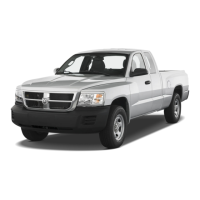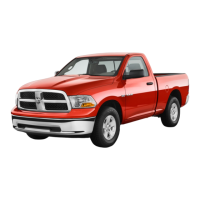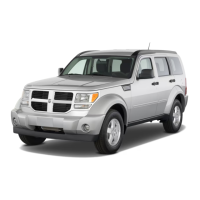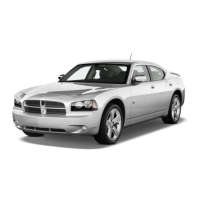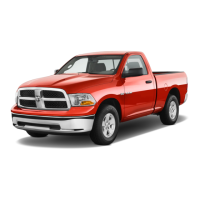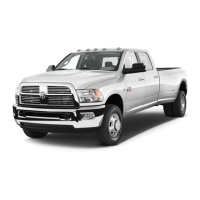Do you have a question about the Dodge 2010 Dakota and is the answer not in the manual?
Provides guidance on navigating the owner's manual using its table of contents and index.
Details warnings about operating procedures that could cause accidents or injury, and cautions about vehicle damage.
Explains the location and importance of the Vehicle Identification Number (VIN).
Warns that modifications or alterations can affect roadworthiness, safety, and may lead to injury or death.
Information about key code numbers and ordering duplicate keys from the authorized dealer.
Details the Sentry Key immobilizer system that prevents unauthorized vehicle operation by disabling the engine.
Covers essential safety features like three-point seat belts, airbags, and child restraint systems for occupant protection.
Details the operation of power windows, including auto-down and window lockout features.
Information on inside day/night mirror, automatic dimming feature, and outside mirror adjustment.
Explains the voice-activated, hands-free in-vehicle communication system and its operation.
Details how to operate the voice command system for controlling various vehicle functions.
Explains how to activate, set, deactivate, and resume the cruise control system.
Presents a diagram and numbering of the instrument cluster components and indicators.
Warns of an overheated engine condition and provides essential safety instructions.
Monitors emissions and engine control systems, alerting to potential issues.
Warns the driver about low tire pressure and system malfunctions.
Monitors the ABS system and illuminates if a malfunction is detected.
Covers initial steps before starting the vehicle, including seat and mirror adjustment, and seat belt fastening.
Provides instructions for starting the engine under normal warm or cold conditions.
Details the operation of the automatic transmission, including gear ranges and interlock systems.
Explains the operation of the electric-shift transfer case and its modes.
Offers precautions to observe when driving on wet, slushy, or hydroplaning-prone roads.
Provides safety tips and information on limits for towing trailers with the vehicle.
Explains the function and usage of the hazard warning flasher switch for emergencies.
Covers the location of the jack, tools, and the procedure for changing a tire.
Step-by-step instructions on how to access and remove the spare tire from its stowage compartment.
Provides critical safety warnings and instructions for safely changing a tire.
Outlines the necessary preparations and steps for safely jump-starting a vehicle.
Offers advice on how to move a vehicle stuck in snow, sand, or mud using a rocking motion.
Identifies key components within the engine compartment for the 3.7L engine.
Explains the OBD II system, Malfunction Indicator Light (MIL), and emissions testing readiness.
Covers checking engine oil level, changing oil, and selecting the correct oil type and viscosity.
Covers coolant checks, drain/flush procedures, and pressure cap warnings.
Details fluid level checks, master cylinder, and brake system warning lights.
Explains how to check the automatic transmission fluid level and cautions related to fluid.
Highlights scheduled maintenance for the emissions control system to ensure proper function.
Explains the oil change indicator system and general service reminders.
Lists the recommended maintenance intervals for various vehicle components and services.
Provides tips for preparing for service appointments and maintaining a vehicle history log.
Emphasizes the importance of using authorized dealers for warranty service and quality repairs.
Lists contact information for customer assistance in the US and Canada, and Mexico.
Instructs how to report safety defects to NHTSA and Transport Canada.
Explains DOT tire grading categories: Treadwear, Traction, and Temperature.
Provides guidance on navigating the owner's manual using its table of contents and index.
Details warnings about operating procedures that could cause accidents or injury, and cautions about vehicle damage.
Explains the location and importance of the Vehicle Identification Number (VIN).
Warns that modifications or alterations can affect roadworthiness, safety, and may lead to injury or death.
Information about key code numbers and ordering duplicate keys from the authorized dealer.
Details the Sentry Key immobilizer system that prevents unauthorized vehicle operation by disabling the engine.
Covers essential safety features like three-point seat belts, airbags, and child restraint systems for occupant protection.
Details the operation of power windows, including auto-down and window lockout features.
Information on inside day/night mirror, automatic dimming feature, and outside mirror adjustment.
Explains the voice-activated, hands-free in-vehicle communication system and its operation.
Details how to operate the voice command system for controlling various vehicle functions.
Explains how to activate, set, deactivate, and resume the cruise control system.
Presents a diagram and numbering of the instrument cluster components and indicators.
Warns of an overheated engine condition and provides essential safety instructions.
Monitors emissions and engine control systems, alerting to potential issues.
Warns the driver about low tire pressure and system malfunctions.
Monitors the ABS system and illuminates if a malfunction is detected.
Covers initial steps before starting the vehicle, including seat and mirror adjustment, and seat belt fastening.
Provides instructions for starting the engine under normal warm or cold conditions.
Details the operation of the automatic transmission, including gear ranges and interlock systems.
Explains the operation of the electric-shift transfer case and its modes.
Offers precautions to observe when driving on wet, slushy, or hydroplaning-prone roads.
Provides safety tips and information on limits for towing trailers with the vehicle.
Explains the function and usage of the hazard warning flasher switch for emergencies.
Covers the location of the jack, tools, and the procedure for changing a tire.
Step-by-step instructions on how to access and remove the spare tire from its stowage compartment.
Provides critical safety warnings and instructions for safely changing a tire.
Outlines the necessary preparations and steps for safely jump-starting a vehicle.
Offers advice on how to move a vehicle stuck in snow, sand, or mud using a rocking motion.
Identifies key components within the engine compartment for the 3.7L engine.
Explains the OBD II system, Malfunction Indicator Light (MIL), and emissions testing readiness.
Covers checking engine oil level, changing oil, and selecting the correct oil type and viscosity.
Covers coolant checks, drain/flush procedures, and pressure cap warnings.
Details fluid level checks, master cylinder, and brake system warning lights.
Explains how to check the automatic transmission fluid level and cautions related to fluid.
Highlights scheduled maintenance for the emissions control system to ensure proper function.
Explains the oil change indicator system and general service reminders.
Lists the recommended maintenance intervals for various vehicle components and services.
Provides tips for preparing for service appointments and maintaining a vehicle history log.
Emphasizes the importance of using authorized dealers for warranty service and quality repairs.
Lists contact information for customer assistance in the US and Canada, and Mexico.
Instructs how to report safety defects to NHTSA and Transport Canada.
Explains DOT tire grading categories: Treadwear, Traction, and Temperature.
| Brand | Dodge |
|---|---|
| Model | 2010 Dakota |
| Category | Automobile |
| Language | English |
